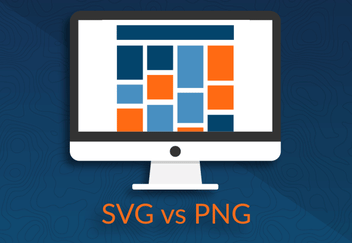We have all experienced the misuse of certain file types. A large print piece, or direct mailer with a distorted and pixelated image, or a Facebook profile picture that appears grainy. The amount of file types and attributes associated with them can at times seem a bit daunting. Using the correct file types in your marketing procedures is important when dealing with print materials as well as online marketing campaigns and websites. There is a very good reason for these file type variations in that each does something specifically better then the others. I will be walking you through a few common file types I deal with on a regular basis, and explain the best uses of each. We will also be discussing the proper ways to generate such file types to ensure quality is translated from your designer to the (potential) clients.
RASTER IMAGES

A raster or bitmap image is composed of a dot matrix structure generally contained within a rectangular grid. Raster images are dependent on resolution and cannot be scaled freely without sacrificing quality. Raster Images are geared more towards photographs or realistic images. When dealing with raster images for print it is important to keep resolution in mind as most process printer’s can far out preform the typical PPI of a computer monitor. Raster files for printing ideally have a resolution of 300 DPI (dots per inch). Common types of Raster images include but are not limited to:
Jpeg
Jpegs may be the most recognizable of the raster image file types. It is often the format that digital cameras use, as well as web materials. Jpegs are often used because they are a compressed file type, which is important when dealing with file size issues. Because of this compression, certain aspects of a piece will be automatically discarded in the process, making the jpeg file type a lossy format. Lossy format refers to data being lost by compression. This loss of quality is less apparent in photographs but very noticeable in textual works or pieces with sharp contrast. Jpegs can also become pixelated when scaled up or down. Facebook for instance automatically will scale down your profile image to fit within its template. For photos this isn’t noticeable, however when organizations try to upload their logo they may experience this issues if the jpeg was not properly generated to size. In these instances a lossless graphic format should be used.
PNG (portable network graphic)
A png is another somewhat recognizable file format to the average person. The png is also an example of a lossless graphic format as was mentioned previously, and is the most used version of this on the entire Internet! A lossless graphic format simply means that the file can be perfectly reconstructed from compressed data. PNGs do not support color profiles such as CMYK and therefore should not be used for printing purposes. Another cool feature that PNGs support is the ability to incorporate transparencies in the image. This is especially useful in web building.
TIFF (tagged image file format)
The tiff format is flexible and uses the .tif or .tiff extension. The flexibility of this format can at times make it a bit more difficult to manage. It can be either lossy or lossless, and some digital cameras also shoot in this format. Tiffs also allow for a wide range of color schemes and color spaces, which are specified in dedicated tags. The use of these tags is also something unique with the TIFF file. Tiffs also allow for multiple pages, or layers in a single file, which works well for editing later in Photoshop for instance.
OTHER RASTER FILES
.Exif (Exchangeable image file format)
RAW (Raw Image Format)
Gif (Graphics Interchange format)
Vector Files

Vector graphics are based on paths and strokes, which are connected via points which control curves and much more. Each of these points has a specified position on a plane. Vector graphics can be considered the opposite of Raster files in that they are made to be completely scalable for their intended use. This allows the same file to be used for a small print piece as well as a billboard without losing quality. This allows graphic designers to save a lot of time in producing different size materials, and also allows them to quickly edit aspects of a design including color changes. Common vector file types are:
EPS (Encapsulated PostScript)
EPS files are the most common exchange vector file type, which means that most vector based software’s will read an eps file regardless of the software it was originally developed in. The eps file format is most commonly used in printing.
SVG (Scalable Vector Graphic)
An svg file is also a common exchange vector file. It can be read by many vector programs and is typically used for web-based functions. SVG files support interaction as well as animation. SVG files utilize XML text files, which means they can be compressed, indexed, and scripted if necessary. Most of the major web browser support SVG files in some capacity.
Other vector file formats (per software)
.ai – vector format used by adobe illustrator
.pdf (portable Document Format) general-purpose file type from adobe
.dxf (drawing exchange format) A CAD format from Autodesk
.cdr – Corel Draw Vector Format
Color models
Color models are mathematical representations of the way color should be represented. Models utilize numbers in these specification, usually in values of 3 or 4 components.
CMYK (process color)
CMYK stands for cyan, magenta, yellow, and black. This color model is widely used in printing and utilizes solely the four aforementioned colors. These four process colors can generate any color when partially or fully masked by each other on a light (usually white) background which makes it ideal for printing. This color model is also used in half tone printing, which utilizes tiny dots small enough for the human eye to perceive it as a solid color. These tiny dots combined with one another can produce the perception of fields of various colors.
RGB
The RGB color model is an additive color model in which red, green, and blue light is added together to produce an array of colors. The main use for RGB is for electronic based applications such as a television or a computer monitor. Different electronic devices produce variations in the RGB color model based on the hardware used by varying manufacturers.
Considering image file types and color models are important for the applications they will be used for. For photos jpegs work well because they are well compressed without people noticing the loss of resolution. PNGs are great to use for graphic based and high contrast raster images in that they will not lose much resolution when scaled to a certain degree. Both can be used in web and print but should be used correctly to ensure that size will not be an issue as well as loss of resolution. Vector files are also important to consider depending on their use. Eps files are best for print while SVG files can have a broad range of capabilities on the web. Finally color models are vary important depending on their intended use. All printers use CMYK files and RGB files should be used to best be displayed on electronic images.
If you have any further questions about which file type or color model will best suit your specific needs, please email me at Rhett@BlueFrogDM.com or give Blue Frog Marketing a click!

